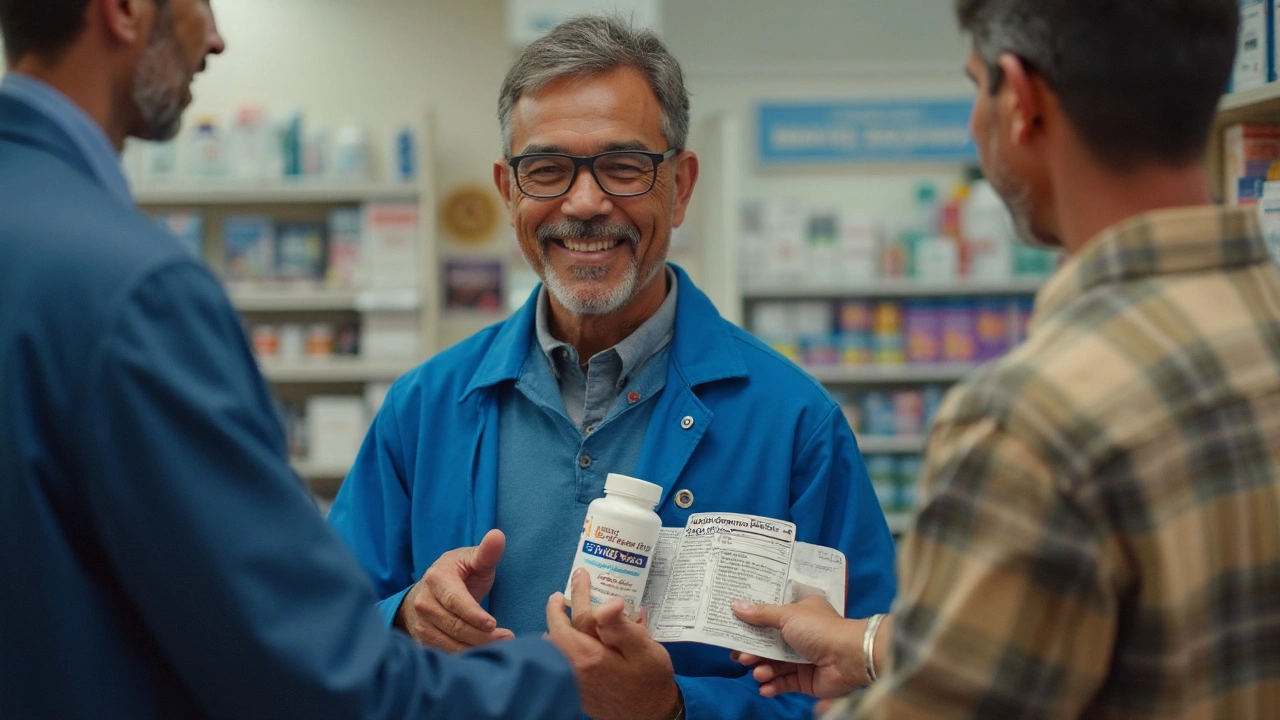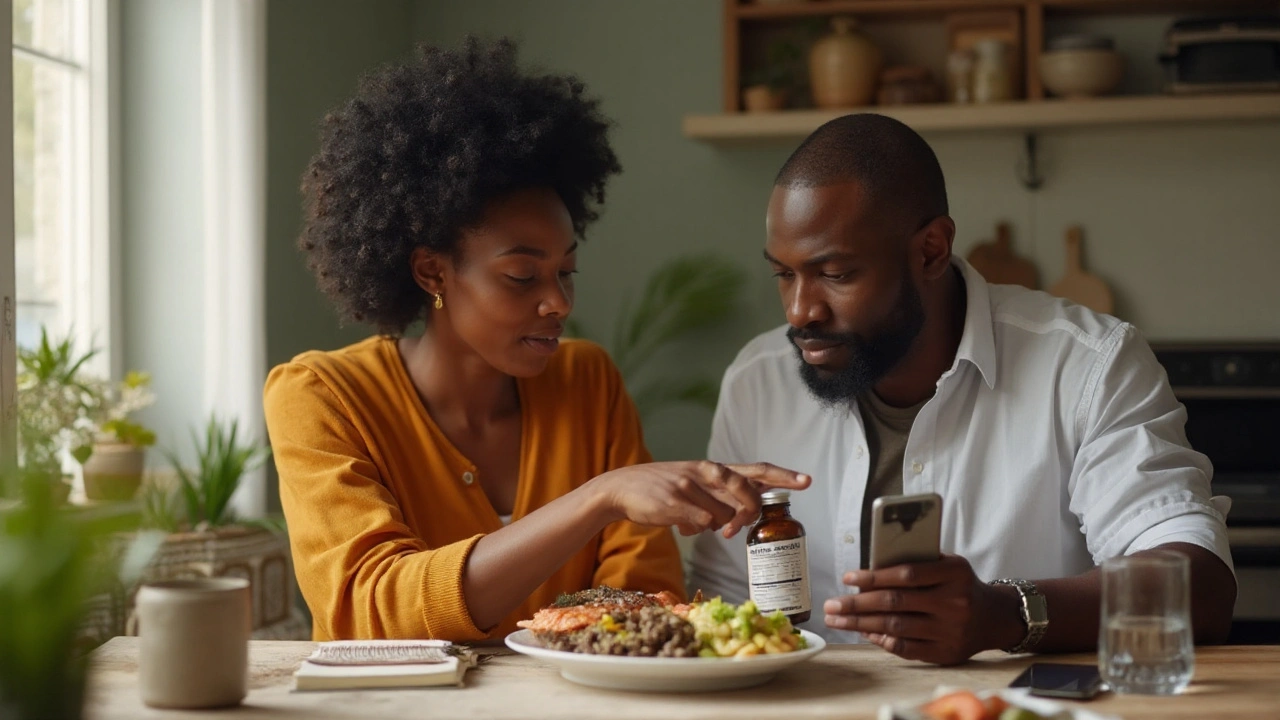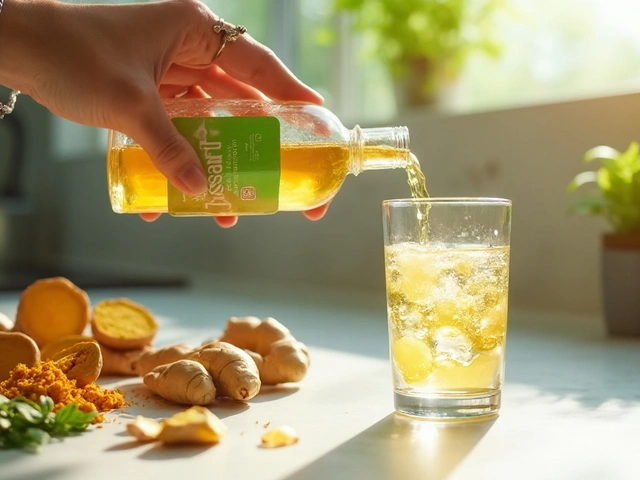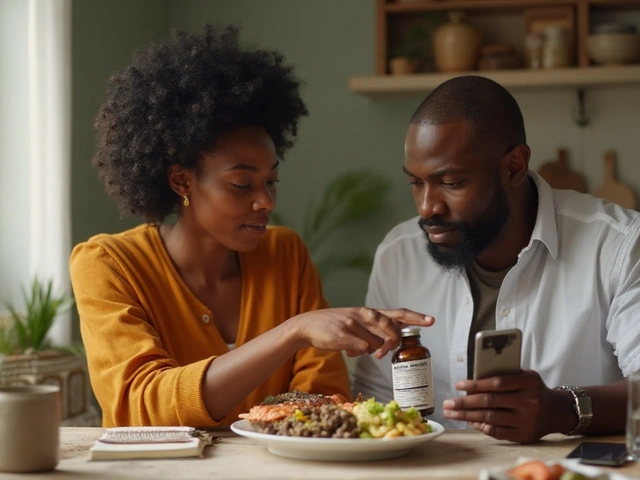Most digestion stumbles in the small intestine, not the stomach. Trypsin is the protein-breaking workhorse there. When your own supply falls short-after a heavy steak, as you age, or if your pancreas under-delivers-you feel it: fullness, gas, or greasy stools. Can a trypsin supplement smooth that out? Yes, in the right cases. This guide shows you when it helps, when it doesn’t, and how to use it safely without wasting money.
- TL;DR: Trypsin is a pancreatic protease that breaks protein into absorbable peptides. Supplements can help protein-heavy meals or mild enzyme gaps, but they’re not a fix for serious pancreatic issues (that needs prescription pancrelipase).
- Best fit: people with high-protein meals, age-related digestive slowdown, or non-specific post-meal heaviness. Not for unexplained weight loss, chronic diarrhea, or oily stools-see a clinician.
- Dose basics: take with the first bite of a protein-containing meal; choose enteric-coated capsules; start low and adjust to symptom relief and stool changes.
- Quality matters: pick third-party tested products (USP Verified, NSF, Informed Choice), clear activity units, and transparent sourcing (porcine vs microbial).
- Safety: avoid if you’re allergic to pork, have active ulcers, recent GI surgery, or you’re on blood thinners without medical advice. Evidence in healthy people is modest; evidence is strong for prescription pancreatic enzymes in exocrine pancreatic insufficiency.
What Trypsin Is and How It Drives Protein Digestion
Trypsin is a protease your pancreas makes and releases into the small intestine to cleave peptide bonds next to lysine and arginine residues. In plain English: it chops long proteins from your food into smaller pieces your gut can absorb. It works alongside chymotrypsin, elastase, and carboxypeptidases. Stomach acid unfolds protein, but trypsin does a big share of the actual cutting.
Here’s the normal flow. When you start eating, your pancreas secretes an inactive precursor called trypsinogen. In the duodenum, an enzyme called enteropeptidase activates it into trypsin. Trypsin then activates more trypsinogen and other enzymes. This cascade is why a small delay or shortage can feel like everything bogs down after a protein-heavy meal.
What happens when you don’t have enough? That depends on how short you are. With mild shortfalls, you might notice post-meal heaviness, gas, or larger stools after high-protein meals. With a severe deficiency-exocrine pancreatic insufficiency (EPI)-you’ll see oily, floating stools, weight loss, and vitamin deficiencies. The American Gastroenterological Association’s guidance (2020) is clear: EPI needs prescription pancrelipase, not an over-the-counter protease.
Where do supplements fit? Over-the-counter options usually combine trypsin with other proteases or bundle them in “pancreatin” blends. Some use porcine pancreas; others use microbial proteases that mimic trypsin-like activity. The U.S. Pharmacopeia has monographs for pancreatin; activity is measured in units, not milligrams. That matters because a small capsule can be potent if the activity per unit is high.
What does the evidence say? High-quality data supports prescription pancreatic enzyme replacement therapy (PERT) for EPI. For otherwise healthy people with meal-related discomfort, data is smaller and mixed. Small randomized trials have suggested enzyme blends can reduce post-meal bloating in functional dyspepsia and IBS, but results vary by formula and dose. A Cochrane-style review in the early 2020s flagged heterogeneity and modest effect sizes. Translation: you may feel better with the right product and timing, but it’s not guaranteed, and it’s not a cure-all.
Aging plays a role. Pancreatic output of enzymes can decline with age. Nutrition and gastroenterology texts note reduced bicarbonate and enzyme secretion in older adults, which can blunt protein digestion. That’s one reason some older folks find that a small, well-timed enzyme capsule takes the edge off heavy meals.
Should You Use Trypsin? Decision Rules, Red Flags, and Who It Helps
Before you spend a dollar, match your situation to the use cases where trypsin tends to help. Here’s a simple decision flow you can run in your head.
- If you have oily, floating, pale stools; unexplained weight loss; or chronic diarrhea-stop. Don’t self-treat. Get evaluated for EPI, celiac disease, IBD, or bile acid issues. PERT is the standard for EPI, and it’s prescription-only for a reason.
- If big protein meals leave you heavy or gassy, but your stools are normal otherwise, a short trial of an enzyme blend with trypsin can be reasonable.
- If you’re an athlete ramping up protein to 1.6-2.2 g/kg/day and notice discomfort, you may benefit from meal-timed enzymes while your gut adapts.
- If you’re 60+ and notice more post-meal fullness than you used to, a cautious trial can make sense, especially with mixed macronutrient meals.
- If you’re vegan or avoid pork for religious reasons, look for microbial “trypsin-like” proteases. They’re not identical to pancreatic trypsin, but many people do well with them.
Set expectations. If your problem is protein digestion at the brush border, trypsin helps upstream but won’t fix lactose intolerance, fructose malabsorption, or bile acid diarrhea. Match the tool to the job: lactase for dairy, alpha-galactosidase for beans, bile acid binders under medical care for bile-related issues, and prescription PERT for EPI. Trypsin is one piece, not the whole puzzle.
What about anti-inflammatory blends that include trypsin and chymotrypsin? Older studies tested these for swelling and sports recovery. Some showed modest benefits, but dosing and formulas varied, and bleeding risk is a concern if you’re on anticoagulants. For digestion, you want enteric-coated enzymes taken with food-not high-dose proteases taken away from meals.
Red flags that call for a clinician, not self-experimentation:
- Unexplained weight loss, anemia, or night sweats
- New-onset fatty, floating stools or foul, persistent diarrhea
- History of pancreatitis, cystic fibrosis, pancreatic surgery, or GI cancer
- GI bleeding, peptic ulcer disease, or recent abdominal surgery
- Use of blood thinners (warfarin, DOACs) or antiplatelet drugs
On the flip side, the green-light scenarios for a trypsin trial are simple: you’re otherwise healthy, your issue tracks with high-protein meals, and you want a practical, reversible test. That’s where a two-week, meal-timed trial shines.

How to Choose, Dose, and Take Trypsin the Right Way
Labels can be a mess. Here’s how to cut through the noise and pick a solid product, then dose it like a pro.
What to look for on the label:
- Activity units, not just milligrams. For proteases, look for USP or FCC activity units. If a label only lists milligrams without activity, skip it.
- Enteric coating. Trypsin is inactivated by stomach acid. Enteric-coated capsules or acid-resistant veggie caps protect enzymes until they reach the small intestine.
- Third-party testing. USP Verified, NSF, or Informed Choice logos indicate identity and potency checks. It doesn’t guarantee efficacy, but it filters out bad actors.
- Transparent sourcing. Porcine pancreatic enzymes are closest to human, but many prefer microbial options. Either can work; choose based on ethics, allergy, and tolerance.
- Balanced formula. For mixed meals, a blend that includes protease (trypsin/chymotrypsin or trypsin-like activity), lipase, and amylase often performs better than trypsin alone.
Dosing rules of thumb:
- Timing: take it with the first bite of a protein-containing meal. If the meal is long (more than 45 minutes), a second smaller dose halfway can help.
- Starting dose: for a typical mixed meal, begin with a protease activity in the low-to-moderate range as listed by the brand (often labeled as “protease” units). If the label lists trypsin specifically, standard potencies range widely, so follow brand-specific activity guidance and start low.
- Adjust by feedback: aim for less post-meal heaviness, less gas, and normal stools. If stools become loose, you may be overdosing or not need it for that meal.
- Protein load scaling: bigger protein meals need more enzyme support. Light salad? Skip it. Steak night? Take it.
- Do not crush enteric-coated capsules. Swallow whole so they survive stomach acid.
What about exact numbers? Unlike prescription PERT (where lipase units per meal are standardized), supplement trypsin potency varies. Many effective consumer products deliver a modest protease activity per meal that maps to one to two capsules depending on the brand’s unit system. Because the systems differ (USP, FCC, HUT), your best bet is to follow brand directions, then titrate to comfort and stool response. If you need more than the maximum label dose to feel okay, you may have a bigger issue worth checking.
Common pitfalls:
- Expecting trypsin to fix lactose intolerance or FODMAP issues-it won’t. Use the right enzyme (lactase, alpha-galactosidase) for those carbs.
- Taking it on an empty stomach for digestion support. Digestive enzymes belong with food. Away-from-meal dosing is a different use case and can irritate.
- Buying capsules without enteric protection. Acid destroys trypsin. No coating, no benefit.
- Confusing milligrams for activity. A big milligram number without activity units is a red flag.
- Ignoring source. If you avoid pork, confirm microbial protease. If you have soy sensitivities, check excipients.
| Use case | Best product type | Typical per-meal protease/trypsin | Evidence strength | Notes |
|---|---|---|---|---|
| Heavy protein dinner (steak/chicken) | Enteric-coated blend with trypsin + chymotrypsin or trypsin-like protease | Brand-directed starting dose; increase by 1 capsule if symptoms persist | Moderate for symptom relief | Adjust to meal size; aim for less heaviness/gas |
| Mixed meals (protein + fat + carbs) | Pancreatin-style blend (protease + lipase + amylase) | One capsule with first bite; add a second for large meals | Low to moderate | Lipase can help with fatty foods; watch stool changes |
| Aging-related digestive slowdown | Low-dose, enteric-coated protease blend | Lowest effective dose per brand; use only with larger meals | Low to moderate | Trial for 2-3 weeks; reassess need |
| Exocrine pancreatic insufficiency (EPI) | Prescription pancrelipase (PERT) | Standardized lipase units per AGA guidance | High | See clinician; OTC trypsin is not a substitute |
| Vegan/porcine-free preference | Microbial “trypsin-like” protease blend, enteric-protected | Brand-directed dose; match to meal size | Low to moderate | Good option if avoiding animal products |
Safety and interactions:
- Allergy: avoid porcine-sourced enzymes if you’re allergic to pork. Check labels for excipients.
- Ulcers/GI surgery: proteases can irritate active ulcers or fresh surgical sites. Get cleared first.
- Anticoagulants: high-dose protease blends have been linked to bleeding risk in older trials. If you’re on warfarin or DOACs, get medical input before use.
- Pregnancy: safety data is limited for supplements. If you’re pregnant or breastfeeding, ask your clinician.
- Kids: don’t use as a shortcut for picky eating. Pediatric use should be supervised.
Credibility check: The American Gastroenterological Association’s 2020 clinical update outlines dosing for prescription PERT in EPI. The NIH Office of Dietary Supplements (2024) notes variability in over-the-counter digestive enzyme products and the need for standardized activity units. A 2018 review in Journal of the Pancreas summarizes effective PERT strategies post-pancreatic disease. For non-disease meal comfort, existing randomized trials are small, with modest benefits and brand-specific effects. That’s why picking a verified product and dosing by feedback matters most.
Checklists, Examples, and Quick Answers
Here’s the practical kit you can use today-checklists, real-world examples, and answers to the questions I hear the most.
Jobs you likely came here to get done:
- Understand what trypsin does and whether it fits your problem
- Decide if you should try a product or see a clinician
- Choose a quality capsule that isn’t junk
- Know when and how much to take
- Avoid common mistakes and side effects
Quality checklist (5 items that actually matter):
- Has activity units (USP, FCC, or HUT) clearly listed
- Enteric-coated or acid-resistant capsule
- Third-party tested (USP Verified, NSF, or Informed Choice)
- Transparent sourcing (porcine vs microbial) with allergen disclosure
- Reasonable dose per capsule; no “kitchen sink” of 20+ enzymes with tiny activities
Simple 2-week trial plan:
- Pick a trustworthy, enteric-coated protease blend with listed activity units. Aim for a formula that includes trypsin or a trypsin-like protease.
- Use it only with protein-containing meals. Take with the first bite.
- Start at the lowest effective brand-directed dose. Keep the rest of your diet steady.
- Track three things: post-meal heaviness (0-10), gas/bloating, and stool form using the Bristol scale.
- After 3-5 meals, adjust up by one capsule for big meals if needed. If stools loosen or cramp, step back down.
- At the end of week two, evaluate: if you notice clear benefit with no downsides, keep it for big meals only. If no benefit, stop-save your cash and reconsider other causes.
Examples to make this real:
- Weekend barbecue: you’re having ribs and brisket. Take one enteric-coated capsule with the first bite. If you’re going back for a second plate 45 minutes later, take a second half-dose with the second plate.
- Post-workout shake + big dinner: skip enzymes for the shake; use one capsule with the main meal. Your shake digests fast; the dinner is where enzymes help.
- Date-night Italian: lots of fat and protein. A blend with protease and lipase often beats pure trypsin here. Take one with the first bite, then reassess halfway.
Mini-FAQ:
- Can I take trypsin every meal? If every meal needs help, look deeper. Daily reliance may mask a bigger issue like EPI, celiac, or SIBO. Use it for bigger meals, not snacks.
- Is plant-based protease as good? For basic symptom relief, many do fine with microbial proteases. They’re not identical to pancreatic trypsin, but they can reduce heaviness after protein-heavy meals.
- Will this help heartburn? Not directly. For reflux, meal size, timing, and trigger foods matter more. Enzymes don’t neutralize acid.
- Any side effects? The most common are mild GI changes: nausea, abdominal discomfort, or loose stools if you overdo it. True allergies are rare but possible with animal-sourced products.
- What about combining with probiotics? Safe for most people. Probiotics modulate gut flora; enzymes work on food. If you’re sensitive, add one change at a time.
Next steps and troubleshooting by persona:
- Athlete on high protein: keep protein targets steady for two weeks. Add one capsule with your largest two meals. If no change, consider spacing protein across more meals to ease the load.
- Busy parent with post-meal bloat: first, shrink portion size and slow your eating. If heaviness sticks around with protein-rich dinners, try a small, enteric-coated protease. If bread and milk are your main triggers, look at lactose or FODMAPs instead.
- Older adult noticing more fullness: ask your clinician to rule out anemia, thyroid issues, and medication side effects. If labs are fine, a low-dose, enteric-coated enzyme with larger meals can be a simple test.
- Vegan/porcine-free: choose microbial protease with enteric protection. If you often eat legumes and crucifers, consider adding alpha-galactosidase for those meals.
- History of pancreatitis or GI surgery: skip over-the-counter enzymes until your GI team weighs in. Prescription PERT might be indicated.
A quick word on marketing claims: “10,000 mg protease!” means nothing without activity units. Activity, not weight, does the work. Look for clear units and third-party seals. If a brand won’t tell you the activity, pick another brand.
Bottom line you can act on today: if your main issue is feeling heavy after protein-heavy meals, a short, structured trial of a quality trypsin supplement-or a protease blend with enteric protection-can be worth it. Keep your expectations grounded, track your response, and loop in a clinician if symptoms are severe or persistent.









Sage Druce
August 31, 2025 AT 00:58Been using trypsin for six months now after my steak dinners started feeling like concrete
Low dose enteric coated blend with microbial protease
No more bloating after grilled chicken
Not magic but it works
Tanuja Santhanakrishnan
August 31, 2025 AT 23:12As someone from India where lentils and legumes dominate our plates
I tried trypsin thinking it’d help with protein overload
Turns out it’s useless for dal
But wow did it help when I ate that butter chicken curry with double chicken
Turns out animal protein is where it shines
Microbial version works fine
And no pork guilt
Just take it with the first bite or it’s just expensive chalk
Raj Modi
September 1, 2025 AT 20:58While the article presents a clinically nuanced perspective on trypsin supplementation
I must emphasize that the physiological cascade involving enteropeptidase-mediated activation of trypsinogen remains a critical determinant of enzymatic efficacy
Moreover, the pharmacokinetic variability between porcine and microbial proteases necessitates individualized titration
Studies by Kehagias et al. (2021) indicate that microbial proteases exhibit a broader pH stability profile
Yet their catalytic efficiency for lysine-arginine cleavage remains approximately 18% lower than porcine trypsin
Therefore, while microbial alternatives are ethically preferable
They may require dosage adjustment in patients with high protein intake
Additionally, the absence of standardized regulatory frameworks for OTC enzyme supplements introduces significant inter-brand variability
One must prioritize products with verified USP or FCC units
Milligram content alone is a marketing illusion
As a gastroenterology researcher
I urge users to recognize that symptom relief does not equate to physiological normalization
Chronic postprandial heaviness may mask subclinical pancreatic dysfunction
Always consult before long-term use
Cecil Mays
September 2, 2025 AT 18:36OMG YES this is life changing 😍
I’m an athlete and my protein shakes were killing me
Now I take one capsule with my steak dinner and boom
No more bloating for 3 days straight
Also don’t buy the cheap stuff
I got the USP Verified one and it’s worth every penny
Also trypsin + lipase combo is the real MVP for fatty meals
Sarah Schmidt
September 3, 2025 AT 14:42People treat digestive enzymes like vitamins
They’re not
They’re pharmaceutical-grade catalysts
And you’re playing with your gut’s delicate biochemistry
That’s not wisdom
That’s self-medication dressed up as wellness
If your body can’t digest steak
Maybe stop eating steak
Or better yet
Stop pretending your body is a chemistry lab you can hack with capsules
This isn’t biohacking
This is denial
And you’re just delaying the inevitable visit to the GI specialist
Billy Gambino
September 4, 2025 AT 08:15Trypsin is a proteolytic enzyme derived from porcine pancreatic tissue
But what if the source isn’t what they say it is
What if the ‘microbial’ enzymes are actually genetically modified strains engineered to mimic trypsin
And what if the FDA doesn’t require full disclosure of genetic modifications in dietary supplements
And what if the ‘USP Verified’ label is just a paid marketing badge
And what if your ‘digestive relief’ is just masking a deeper systemic inflammation triggered by industrial food processing
And what if the real issue is glyphosate residues in your meat
Not enzyme deficiency
And what if trypsin supplements are just another corporate distraction from the truth
Ask yourself
Who profits when you believe you need this
Karen Werling
September 4, 2025 AT 13:31I’m 68 and used to feel like I swallowed a rock after chicken
Started with one low-dose capsule
Now I only use it on weekends when I have a big meal
My stool’s normal again
And I don’t feel like I need a nap after dinner
It’s not a cure
But it’s a quiet win
Also I love that it’s not some fancy pill with 17 enzymes
Just trypsin + lipase
Simple works
And yes I use the microbial one
Respect the vegan folks
STEVEN SHELLEY
September 4, 2025 AT 22:07THEY DON’T WANT YOU TO KNOW THIS BUT TRYPSIN IS A CONTROL MECHANISM BY THE PHARMA INDUSTRY TO KEEP YOU DEPENDENT ON PILLS WHILE THEY SELL YOU PRESCRIPTION PANCRELIPASE AT 300% MARKUP
THEY MAKE YOU THINK YOU NEED IT THEN THEY SELL YOU THE REAL STUFF
THEY USE THE SAME LABS TO TEST BOTH
AND THE USP LOGO IS A SCAM
THEY JUST WANT YOU TO SPEND MONEY
THEY KNOW YOU’LL BUY IT
AND THEN YOU’LL BE STUCK
THEY WANT YOU TO BE SICK
THEY’RE THE ONES WHO OWN THE PANCREAS RESEARCH
TRUST NO ONE
GO RAW
FAST
AND STOP TAKING ENZYMES
Emil Tompkins
September 5, 2025 AT 17:22Okay so I tried this
And I swear I felt better
Then I realized I also drank less soda that week
And slept more
And didn’t eat fried chicken
So was it the trypsin
Or just not being an idiot
Also
I bought the cheapest one
It had no enteric coating
And I still took it
And nothing happened
So maybe it’s not the supplement
Maybe it’s the fact that we’re all just too lazy to chew properly
And too addicted to processed meat
And too cheap to buy better food
But hey
At least I have a pill to blame
Kevin Stone
September 5, 2025 AT 22:17People are too quick to self-diagnose
You feel bloated after steak
So you buy trypsin
But what if it’s your stress
Or your sleep
Or your gluten
Or your dairy
Or your water intake
Or your lack of movement
Or your poor chewing
Or your 3pm coffee
Instead of fixing your life
You buy a capsule
And call it science
It’s pathetic
Natalie Eippert
September 6, 2025 AT 14:21Why are we letting foreigners sell us enzyme supplements
When American companies could make them
And why are we trusting microbial enzymes from India
When porcine is proven
And why are we letting vegans dictate what we take
Our ancestors ate pork
And they digested it fine
Now we’re afraid of our own biology
And we pay for fake enzymes
It’s a cultural collapse
kendall miles
September 7, 2025 AT 02:52Trypsin supplements are a Trojan horse
They’re not about digestion
They’re about conditioning you to accept pharmaceutical dependency
The same labs that certify these
Also certify prescription drugs
And the same FDA panels approve both
And the same corporations own both
They want you to think you need a pill for every minor discomfort
So when your pancreas really fails
You’ll be ready to pay $800 for PERT
They’ve been training you for years
Wake up
Bob Martin
September 7, 2025 AT 23:05Wow
Someone actually wrote a useful guide
Not just a list of buzzwords
And didn’t sell me a 100-enzyme miracle blend
Respect
I’ve been using trypsin for a year
Only with big meals
Microbial
USP verified
And it works
But I don’t take it with my eggs
Because I’m not an idiot
And I don’t blame the supplement when I eat a whole pizza
It’s not magic
It’s just helpful
Tyler Mofield
September 8, 2025 AT 04:54It is axiomatic that exogenous proteolytic supplementation constitutes a palliative intervention predicated upon a functional deficit in endogenous pancreatic secretion
Yet the ontological assumption that such supplementation constitutes a therapeutic modality is epistemologically unsound
For the symptomatology of postprandial distension
Is not synonymous with enzymatic insufficiency
But rather a manifestation of dysmotility
Or visceral hypersensitivity
Or dietary indiscretion
Or psychological stress
To ascribe causality to trypsin is to commit the post hoc fallacy
And to elevate placebo into protocol
One does not cure a system by adding a catalyst
One restores balance
By removing the burden
Not by supplementing the deficiency
Patrick Dwyer
September 8, 2025 AT 05:29Just want to say this is one of the most balanced guides I’ve read
Not hype
Not fear
Just facts
I’ve been a dietitian for 18 years
And I’ve seen people waste hundreds on enzyme blends that don’t even have enteric coating
So thank you for the clarity
For older adults
It’s not about replacing enzymes
It’s about supporting digestion
With timing
With portion
And yes
With the right supplement
When needed
And always
With a doctor if things don’t improve
Bart Capoen
September 8, 2025 AT 06:22i tried the trypsin thing after reading this
took one with my chicken dinner
felt a lil better
but honestly
i think i just ate slower that night
and drank water
and didn’t watch my phone while eating
so maybe it’s not the pill
maybe it’s just… being a human
also the microbial one i got
had a weird aftertaste
like chalky soy
so i stopped
but i’ll try again if i get a bad steak night
for now
i just chew more
Sage Druce
September 8, 2025 AT 06:30Just read the one about microbiome and enzyme synergy
Good point
I’ve been taking probiotics too
And yeah
My digestion is smoother
But I still need the trypsin for steak night
They’re not the same thing
Probiotics help the gut
Trypsin helps the food
Both matter